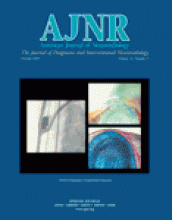Abstract
Summary: A case of congenital anastomosis between the vertebral artery and internal carotid artery is presented. This rare anomaly was an incidental finding at cerebral angiography in a patient with a suspected ruptured cerebral aneurysm with subarachnoid hemorrhage.
This case report describes a case of anastomosis between the vertebral artery and internal carotid artery in a patient with a suspected ruptured cerebral aneurysm. There was also an absence of communication between the common carotid and cervical internal carotid artery. Such findings are extremely rare.
Case Report
A 75-year-old man presented with sudden collapse. On admission to our institution, the patient was still unconscious. Glasgow coma scale on examination was 7/15. Blood pressure and pulse were stable. Noncontrast cranial CT findings were diffuse subarachnoid hemorrhage (SAH) with intraventricular blood. There was also moderate hydrocephalus.
Owing to the finding of diffuse SAH in a patient without a history of head injury, a cerebral angiography was performed because a ruptured cerebral aneurysm was suspected. A right common carotid arteriogram showed only the right common carotid artery and the right external carotid artery with its peripheral branches. The right internal carotid artery and its branches were not discernible (Fig 1). The right vertebral arteriogram, however, revealed an unexpected filling of contrast material in the right internal carotid artery arising from the cervical portion of right vertebral artery at the level of C2, which was seen on the late arterial phase right vertebral arteriogram (Fig 2A). There was also mild stenosis at the origin of right internal carotid artery with slow flow. The intracranial supply of the right internal carotid artery could not be well demonstrated, probably because of its slow flow (Fig 3A and B). The right middle cerebral artery was supplied mainly by the vertebrobasilar system through the right posterior communicating artery (Fig 2B). The A2 segment of right anterior cerebral artery was supplied by the A1 segment of the left anterior cerebral artery through the anterior communicating artery (Fig 4).
Lateral view of right common carotid arteriogram. There is contrast material filling of the right external carotid artery and its branches. The right internal carotid and its branches cannot be demonstrated.
Fig 2. Lateral view of right vertebral arteriogram. There is contrast material filling of right internal carotid artery (A, arrow). It arises from the cervical portion of right vertebral artery at the level of C2, with mild grade stenosis at its origin. The right middle cerebral artery is supplied by the vertebrobasilar circulation through the posterior communicating artery (B).
Fig 3. Frontal (A) and lateral (B) views of the right internal carotid artery in the right vertebral arteriogram. This artery is shown more clearly during the late arterial phase of the right vertebral arteriogram. The intracranial supply cannot be demonstrated probably due to its slow flow. The right ophthalmic artery is also not well seen due to the same reason.
Fig 4. Frontal view of the left internal carotid arteriogram. The A2 segment of right anterior cerebral artery is supplied by A1 segment of left anterior cerebral artery through the anterior communicating artery.
There was a small saccular dilatation (3 mm) at the origin of the right posterior inferior cerebellar artery, suggestive of a small aneurysm. No abnormality was detected in the cerebral arteries or their branches in the left internal carotid and left vertebral arteriograms.
The patient died 10 days after admission.
Discussion
Anastomotic channels between the carotid and basilar circulatory systems exist early in embryologic development to supply the posterior cranial circulation. These channels, in craniocaudal sequence, are the primitive trigeminal, acoustic, hypoglossal, and proatlantal intersegmental arteries. After the posterior communicating arteries develop, these channels are usually obliterated but may rarely persist into the adult life (1, 2). The most common channel is the persistent trigeminal artery, which communicates with the internal carotid artery in the sellar region and with the distal portion of the basilar artery. This has been observed in 0.1–0.2% of cerebral angiograms (3). Other channels through the acoustic, hypoglossal, and proatlantal intersegmental arteries are even more rare. The persistence of fetal circulation in carotid-vertebrobasilar anastomosis is of clinical significance in the case of surgical or endovascular intervention.
In our case, there was an additional anastomotic channel that was more caudal to the proatlantal intersegmental artery and persisted into adult life. It was located between the cervical portion of the internal carotid artery and the cervical portion of the vertebral artery. In addition, there was a lack of communication between the common carotid artery and the cervical internal carotid artery, which indicates an aplasia of the proximal cervical internal carotid artery. These findings were unique and rare. To the best of our knowledge, there has been only one similar case report published in 1979 (4).
The patient had no history of previous injury or neck surgery. This anastomosis was thought to be congenital in nature, representing an extremely rare form of persistent fetal carotid-vertebrobasilar anastomosis. The genesis of the anastomosis, however, remains uncertain.
Conclusion
To our knowledge, this report presents the second case to appear in the literature of congenital anastomosis between the vertebral artery and internal carotid artery with lack of communication between the common carotid and cervical internal carotid artery. The findings on cerebral angiograms should be interpreted with caution, because persistent fetal carotid-vertebrobasilar anastomosis is of clinical significance in the case of surgical or endovascular intervention.
- Received February 13, 2003.
- Accepted after revision April 13, 2003.
- Copyright © American Society of Neuroradiology








